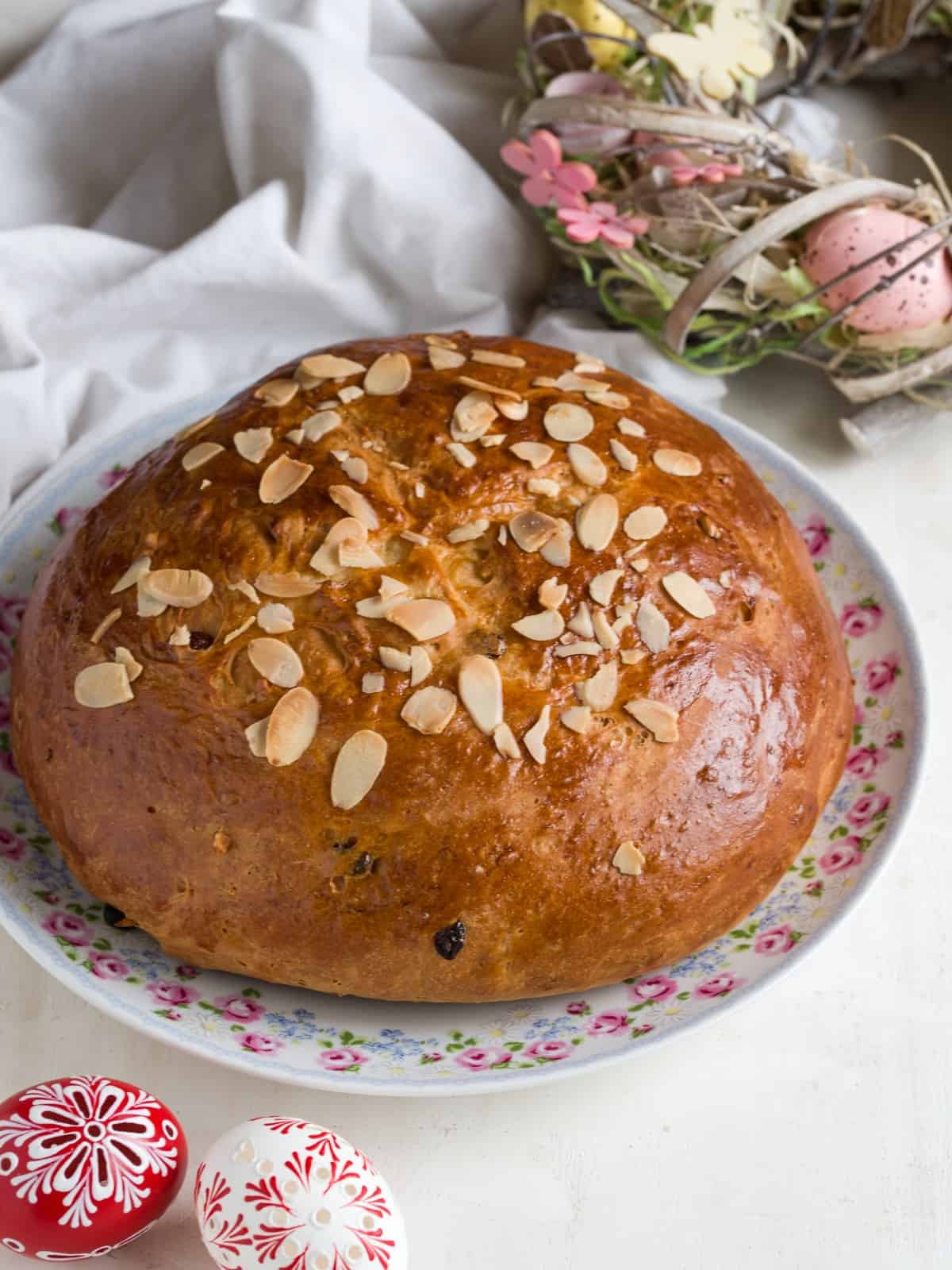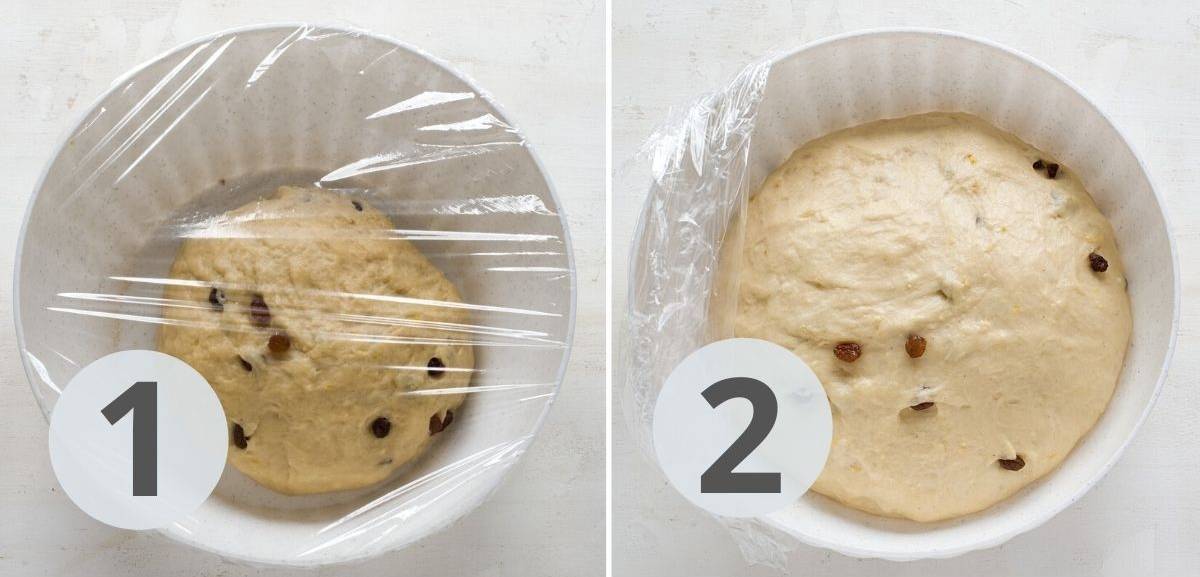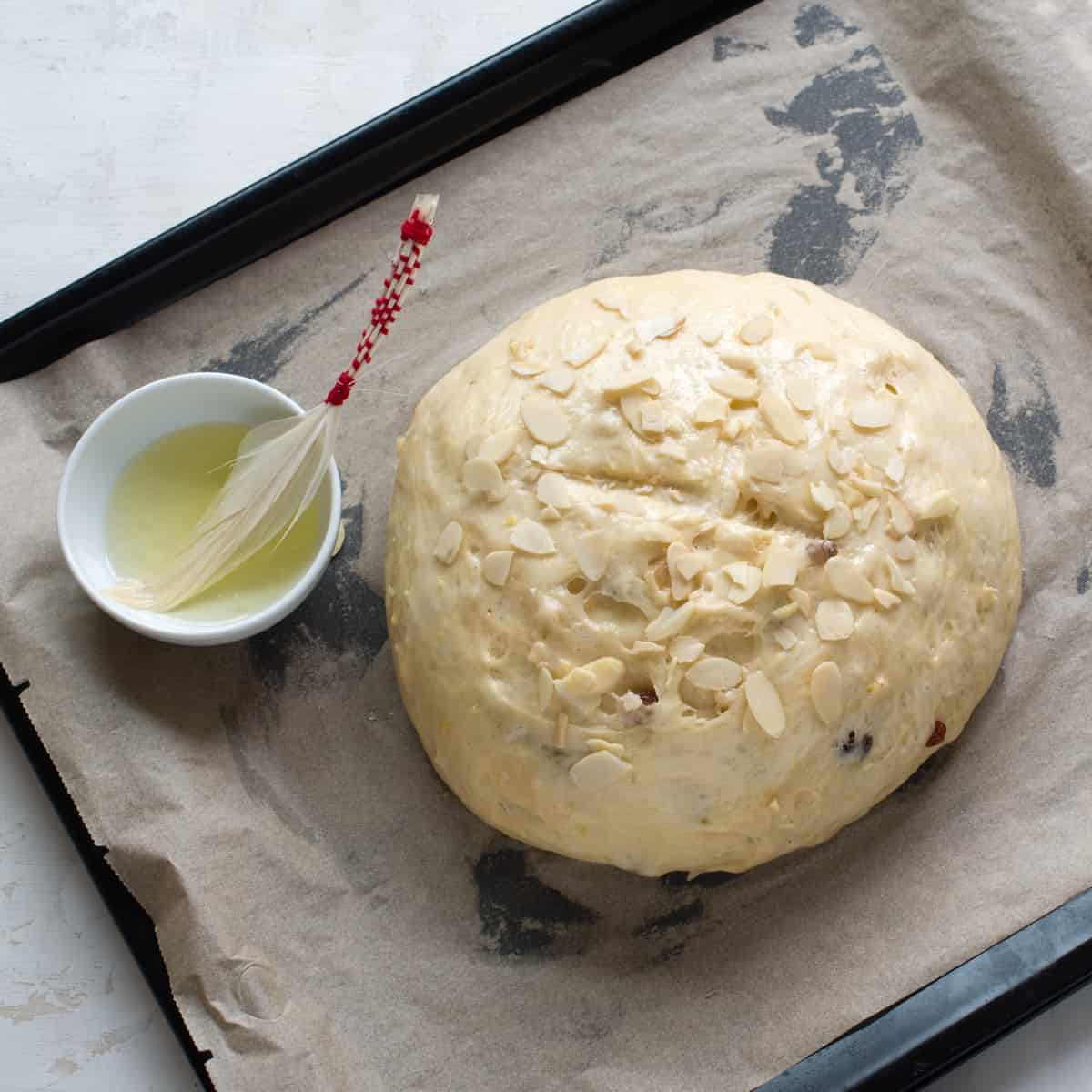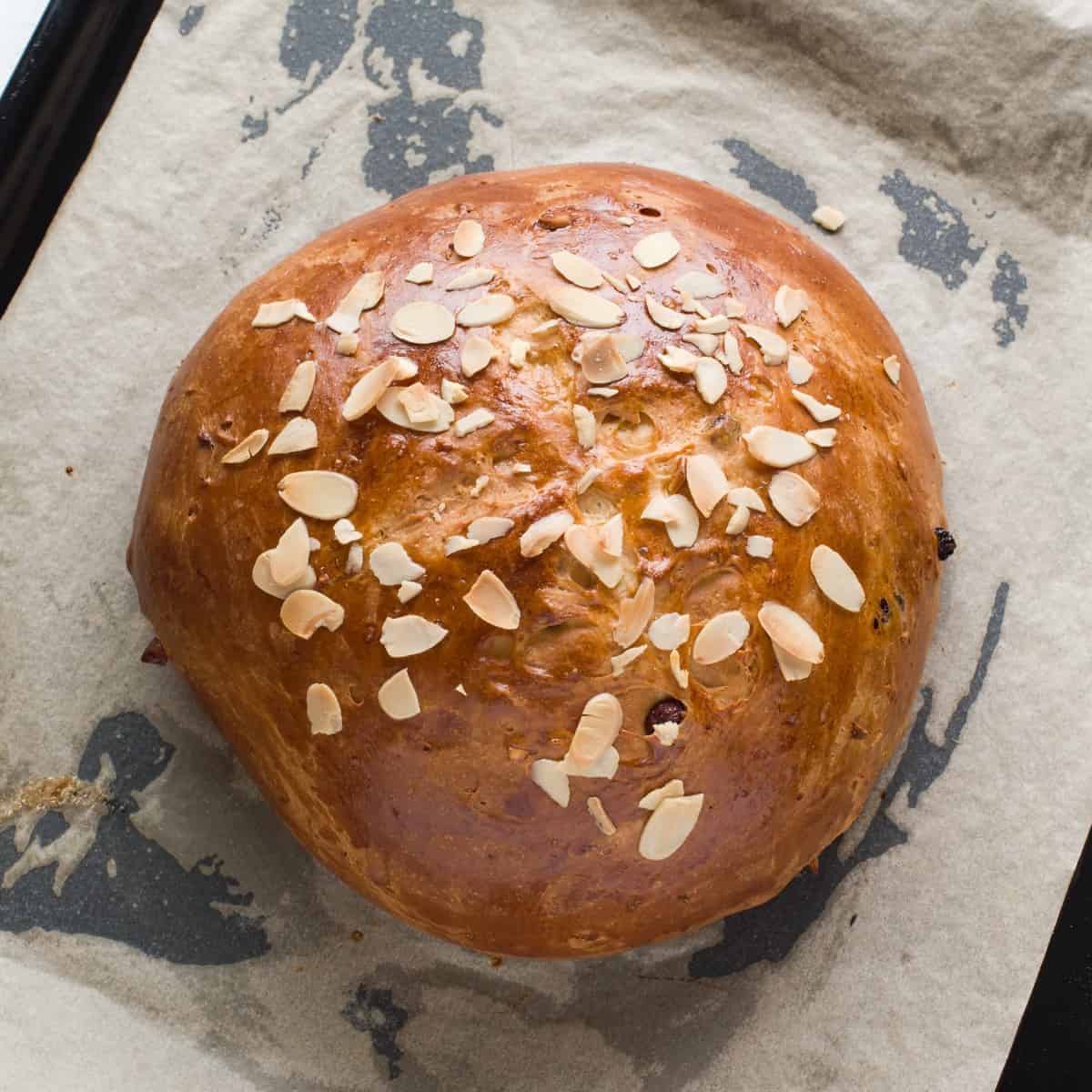When talking about typical Easter treats baked in the Czech Republic, you can’t forget mazanec, sweet Easter bread! Also known as „velikonoční bochánek“, it’s one of Czech Easter’s main symbols.

Making a good homemade mazanec bread is not rocket science, you just need enough time to rise and a little loving care to work the dough.
The dough is very similar to that for Vánočka, or Houska Christmas bread. However, the mazanec is not braided, so it takes an inch less work.
MY TIP: Try also another Czech Easter recipe, honey-coated Jidáše (so yummy!)
➜ What Is Mazanec Bread?
Mazanec is a sweet yeast pastry baked on White Saturday (Holy Saturday). It is shaped like a round loaf, a symbol of the sun, marked with a cross in the middle, and sprinkled generously with almonds. On Easter Sunday, people used to take the mazanec to church to be blessed by the priest.

Curious what makes Czech Easter unique? Learn more details about Czech Easter traditions
Similarly, paska bread is made in eastern Slovakia. Unlike Czech mazanec, Slovak paska tastes less sweet and is served with such delicacies as sausages, ham or boiled eggs!
➜ Ingredients

To prepare Czech Easter bread you need:
- All-purpose flour; for the dough, plus a handful to dust the work surface
- Milk; lukewarm
- Active dry yeast
- Sugar
- Unsalted butter; softened at room temperature. I leave the butter in the microwave for another half minute to soften. Note: the butter must not be hot!
- Eggs; warmed to room temperature. If you forget to take them out of the fridge in time, put the eggs in a saucepan of warm water for a while.
- Lemon zest; preferably from an organic lemon. Scrub the lemon well under warm running water. Grate only the yellow top part, the white layer underneath tends to be bitter.
- Vanilla paste; or vanilla essence
- Raisins; or other soft dried fruit. For better flavor, soak raisins overnight in rum - strain the rum before using.
- Almonds; coarsely chopped for the batter (slivered almonds), and sliced almonds to decorate the mazanec’ surface. Sometimes I use a mixture of nuts in the dough: almonds, walnuts, cashews, and Brazil nuts. I roughly chop the nuts with a chef's knife before adding them to the batter.
- A pinch of salt; for taste contrast
✅ You’ll find the exact amount of ingredients below in the recipe card, which you can also print out.
➜ Instructions with Photos
STEP 1: Pour the lukewarm milk into a cup, and stir in a teaspoon of sugar and the dried yeast. Let stand in a warm place for about 15 minutes until the yeast has risen and bubbles have formed on the surface of the milk.

STEP 2: Remove a piece of egg white from the eggs and reserve it for later. Before baking, it will serve as an egg wash to brush the mazanec bread.
Put the flour, sugar, salt, vanilla, lemon zest, softened butter, and eggs in a large bowl. Pour in the yeast starter, including the milk.

STEP 3: Make the dough: First, roughly mix all the ingredients in the bowl with a wooden spoon, then dump the mass on the work surface. Spread a small handful of flour on the edge of the work surface. Process the dough until it is soft and smooth. If it sticks, always 'dip' it in the spread flour and work it in.
TIP: If you have a kitchen stand mixer with a kneading hook attachment, prepare the dough using it.
STEP 4: Now add the roughly chopped almonds and raisins to the dough and work them into the batter.

STEP 5: Return the dough to the bowl, cover it with plastic wrap, and put it in a warm place to rise for an hour.

⤍ Learn how to make dough rise in the oven.
STEP 6: Knead the dough briefly, shape it into a loaf and place it seam side down on a baking sheet lined with baking paper. Leave in a warm place for another hour and a half to rise.
Give the dough time to rise! The mazanec bread will crack during baking if you rush the second rise.
STEP 7: Make two cross-shaped cuts on the surface - a regular razor blade worked best for me. You can also take a pair of scissors and cut the cross. Using a fork, whisk the egg white you have set aside and brush mazanec on all sides. Sprinkle the surface with sliced almonds.

STEP 8: Place the cake in an oven preheated to 374°F / 190°C (lower and upper heating) for 10 minutes, then turn the temperature down to 320°F / 160°C and bake for a further 30 minutes. If the bread starts to brown too much on the surface, place the foil loosely over it.

➜ Serving
And we're done! Let the baked mazanec cool down. Place the finished bread on a platter and set it on the Easter table. Next to mazanec, arrange some spring flowers and colored Easter eggs.
Eat this delicious bread on its own for Easter morning or Easter brunch. In our family, we spread butter on it, and sometimes we add some jam or honey.
A day or two old mazanec tastes greatly toasted in a frying pan with a knob of butter or dipped in white coffee.

➜ Storage
Mazanec bread tastes best fresh. If you have any leftovers, cover them with plastic wrap and store at room temperature, where they will keep for about 3-4 days.
The bread also freezes well; cut it into slices, place them in an airtight container, and put them in the freezer. There it will keep for about 3 months.
➜ Useful Tips
- The baking time depends on the size of the cake. A mazanec of 10-14 oz (30-40 dkg) of flour needs about 40 minutes in an oven turned to medium temperature 320-338°F (160-170 °C).
- Initially, bake the bread briefly at a higher temperature (I have tested 10 minutes at 374°F / 190 °C) so that the surface firms up and mazanec keeps its shape. Then lower the temperature to that above-mentioned 320-338°F (160-170 °C).
- If the surface of the bread starts to brown excessively during baking, place a sheet of foil over it.
- Not sure whether the bread is done? Make a test for doneness! Stick a wooden skewer into the loaf at the end of baking carefully. If the skewer comes out dry, the bread is cooked; otherwise, leave it to bake for another five minutes and repeat the test.
Keep in mind: Even if the sweet bread tears in the middle when baking, it will still taste delicious!
More Easter recipes:
- Easter lamb cake – velikonocni beranek
- Easter stuffing – nadivka
- Egg salad – easy salad with boiled eggs and yogurt
- Easter biscuits
- Paska Slovak Easter bread
- Sweet Easter braided bread
Or browse the Czech Easter food category for further ideas.
Tried this recipe?
Leave a review down in the comments! ⭐⭐⭐⭐⭐
Follow me on Facebook and Pinterest. Subscribe to my newsletter. Send me any question about Czech cuisine to my e-mail. I love hearing your feedback!

Czech Sweet Easter Bread (Mazanec)
Ingredients
- 3 cups all-purpose flour (390 g) plus for dusting the work surface
- ¾ cup milk (180 ml) lukewarm
- 2 teaspoons active dry yeast
- ½ cup granulated sugar (100 g)
- ½ stick unsalted butter (60 g) softened at room temperature
- 2 eggs remove a piece of egg white from the eggs and reserve it for an egg brush
- 2 und ½ Tablespoons raisins dried
- 2 Tablespoons almonds chopped
- 2 Tablespoons lemon zest freshly grated; the zest from about one small lemon
- ½ teaspoon vanilla paste or vanilla essence
- pinch of salt
For finishing:
- 1 and ½ Tablespoons sliced almonds to garnish
- ½ egg white you reserved earlier when made the dough
Instructions
- Pour the lukewarm milk into a cup, and stir in a teaspoon of sugar and the dried yeast. Let stand in a warm place for about 15 minutes until the yeast has risen, and bubbles have formed on the surface of the milk.
- Remove a piece of egg white from the eggs and reserve it for later. Before baking, it will serve as an egg wash to brush the mazanec bread.
- Put the flour, sugar, salt, vanilla, lemon zest, softened butter, and eggs in a large bowl. Pour in the yeast starter, including the milk.
- Make the dough: First, roughly mix all the ingredients in the bowl with a wooden spoon, then dump the mass on the work surface. Spread a small handful of flour on the edge of the work surface. Process the dough until it is soft and smooth. If it sticks, always 'dip' it in the spread flour and work it in.
- Now add the roughly chopped almonds and raisins to the dough and work them into the batter.
- Return the dough to the bowl, cover it with plastic wrap, and put it in a warm place to rise for an hour.
- Knead the dough briefly, shape it into a loaf and place it seam side down on a baking sheet lined with baking paper. Leave in a warm place for another hour and a half to rise.
- Make two cross-shaped cuts on the surface - a regular razor blade worked best for me. You can also take a pair of scissors and cut the cross. Using a fork, whisk the egg white you have set aside and brush mazanec on all sides. Sprinkle the surface with sliced almonds.
- Place the cake in an oven preheated to 374°F / 190°C (lower and upper heating) for 10 minutes, then turn the temperature down to 320°F / 160°C and bake for a further 30 minutes. If the bread starts to brown too much on the surface, place the foil loosely over it.
Notes
- Makes one 11-inch (28 cm) mazanec bread.
- Give the dough time to rise! The mazanec bread will crack during baking if you rush the second rise.
- SERVING: Let the baked mazanec cool down. Place the finished bread on a platter and set it on the Easter table. Next to mazanec, arrange some spring flowers and colored Easter eggs.
- Eat this delicious bread on its own for Easter morning or Easter brunch. In our family, we spread butter on it, and sometimes we add some jam or honey. A day or two old mazanec tastes greatly toasted in a frying pan with a knob of butter or dipped in white coffee.
DISCLAIMER: Because I come from Central Europe, my recipes are based on metric units such as grams or milliliters. Check out how I convert metric units to the U.S. system:
Conversion chartNutritional Estimate pro portion
Still curious about Czech Easter? Read this article!

Here you’ll find more Czech Easter recipes






Milena Bartik
The best bochanek that I have ever made or eaten. And I have made a lot of them in my life, and eaten as well. So many recipes I have tried, always come out dry. This one even next day so moist. Wow and thank you.
Petra Kupská
Oh! What a lovely comment; thank you very much! I am glad the bochanek/mazanec turned out well. I wish you Happy Easter (veselé Velikonoce) from the Czech 🙂 Petra
Liana
Hi Petra,
I am using your recipe and upon adding 60mls of milk to 2.5 cups of flour I have nowhere enough to make a thin batter. I am having to add much more milk as this is quite a lot of flour. Am I doing something wrong here? Cheers
Petra Kupská
Ahoj Liana, thank you for your comment. For 2 and 1/2 cups of flour, the recipe calls for 1/2 cup of milk, which means 120 milliliters. Could there be a mistake in the amount of milk? Also, the softness of the dough is provided by the melted butter and egg yolks. I know that with yeast dough, it's sometimes alchemy to get the right consistency. I tend to find that the dough is rather stickier and I have to add flour by the spoonful. I hope this helps; if you need anything more clarification, feel free to drop me a line!
Mary
I made this for Easter, and it was fantastic! I used walnuts l, because I don't like almonds. My dad said his baba used to make this but he never knew what it was called so hasn't had it in over fifty years. He's requested it again, as often as possible. Děkuji!!
Petra Kupská
Ahoj Mary, thank you very much for your lovely comment! Although Czechs traditionally prefer almonds, any nuts are suitable for making mazanec bread 🙂 I'm so glad the recipe was a success and your family enjoyed it. Many greetings from Bohemia, Petra
Kat Ptakova
Hi Petra. Is the purpose flour same as hladka mouka? I've been using polohrubou mouku but they have sold out here in London so I was wondering if I could use hladkou. Thanks Kat
Petra Kupská
Ahoj Kat, exactly, all-purpose flour should be the same as Czech hladká mouka, or plain flour in the UK! Since most of my blog visitors are US-based, I bake everything with plain flour, and there is no major problem with it. Fingers crossed, have a blessed Easter! Petra
Wende
Hi Petra,
I am not clear on how much vanilla to use. Also, can I use liquid instead of paste. I'm excited to try this one. I love all your recipes. Our favorite is Livance, the yeast pancakes, we love the texture. Thanks!
Wende
Petra Kupská
Ahoj Wende, thank you for your sharp eye; I forgot to include the amount of vanilla paste in the ingredients list! I've already fixed the mistake. You need 1/2 teaspoon of vanilla paste for the recipe. I believe you can also use a liquid version of vanilla paste – vanilla essence/extract. The vanilla paste I use has a semi-liquid consistency, it is the Dr. Oetker brand. This brand is also available in the US, at least on Amazon. Fingers crossed! Petra
Olga
Happy Easter/Vesele Velikonoce! I made bochanek today and it was excellent! Thank you!
Petra Kupská
Veselé Velikonoce, Olga! And thank you for your lovely feedback 🙂
Jocelyn
My baba used to make this every Easter. I made it this weekend for the first time and it was delicious, děkuji moc Petra for sharing your recipe! It was very fluffy and moist, a perfect texture. Only suggestion i have is adding more raisins, but that is more personal preference as how my family likes it. I will definitely be using this recipe again next Easter!
Petra Kupská
Thank you, Jocelyn, for your kind comment! It is true that mazanec is an Easter bread made by generations of Czech mothers and grandmothers since the ages. Like the lamb cake (beranek), mazanec is a must at Easter 🙂 As for the raisins, it depends on taste and preference (I like more nuts for instance). The most important thing is that you liked the mazanec bread and will give it a chance next year again 🙂 Many greetings from Bohemia, Petra
Jocelyn
Dobrý den Petro,
I am preparing to make mazanec again this year and wanted to ask your advice! I would like to make a few loaves so I can give them out to friends who have never tried it before. I was thinking of using the same measurements but splitting it into 4 small loaves and shortening the baking time. Have you ever done something like this before, and if so, do you have any advice? Děkuju!
P.S. I am learning Czech so hopefully I used the correct declension 🙂
Anicka Cooklikeczechs.com
Dobry den i Vam, Jocelyn,
Mazanec bread can of course be made in a smaller version, the procedure will be the same, only, as you write, shorten the baking time.
The time in the oven will depend on the size of the mini mazanec, I recommend doing the toothpick test for doneness after about 15 minutes of baking - stick a wooden toothpick into the mazanec bread at the highest point and make sure the toothpick comes out clean, without any dough residue. If raw dough sticks to the toothpick, extend the baking time by five minutes and repeat the test until the toothpick is dry.
Hope this helps! The Czech you wrote is perfect - Good luck on learning the language in the future! 🙂
Anna K
Well that was an unexpected success! (unexpected for me at least). I usually suck at baking with yeast but my mazanec is just perfect, thanks to following all the steps as thoroughly as I could. I used half AP and half polohruba, just because I had some and that's how my family does it, it turned out great. I also added 2 tablespoons of spiced rhum, because I like the taste. So thank you for saving Easter! 🙂
Anicka Cooklikeczechs.com
Hello Anna, thank you for your comment, I am delighted the recipe was a success! Vesele Velikonoce!
Carol
Your recipe says to use unsalted butter but how much salt should you use for the dough?
Thank you.
Anicka Cooklikeczechs.com
Hello Carol, thank you for asking - you use just a pinch, for taste contrast. Hope this helps!
Greetings from the Czech Republic.
Doris
Hi! I was so delighted to find your blog and recipe for the Easter bread! My grandmother was of Bohemian Czech ancestry and she made this bread every year. I have not tried the recipe yet but look forward to making it and some of the other familiar foods I remember from childhood. Happy Easter!
Petra Kupská
Thank you, Doris, for your comment! I will be glad if you try any of the recipes on my site and let me know how they turn out!
Usha S
Hi Petra, I’ve baked your dalamanky and vanocka recipes and they both turned out delicious. Today I tried the mazanec. I was nervous as the first rising didn’t rise at all, but I put it in a slightly warmed oven for the second rising and it came out perfect (we are in Canada). I use the bread machine to mix the dough. Thank you for perfect recipes.
Petra Kupská
Hi Usha, thanks a lot for your feedback! I am very happy that the recipes turned out well. It is sometimes alchemy with yeast dough; a lot depends on the environment for how the dough is willing to rise. The trick of putting the dough in a warm oven is great; I do that sometimes. Many greetings from Bohemia to Canada!